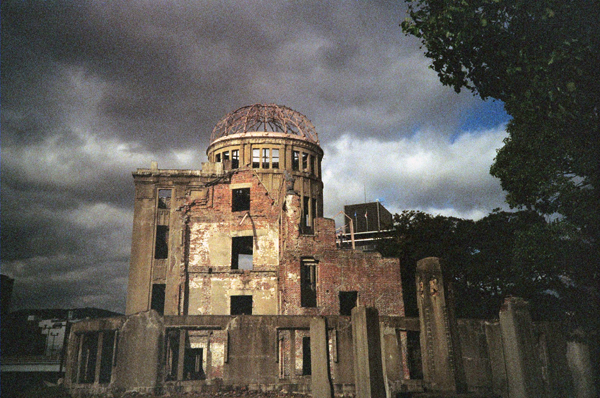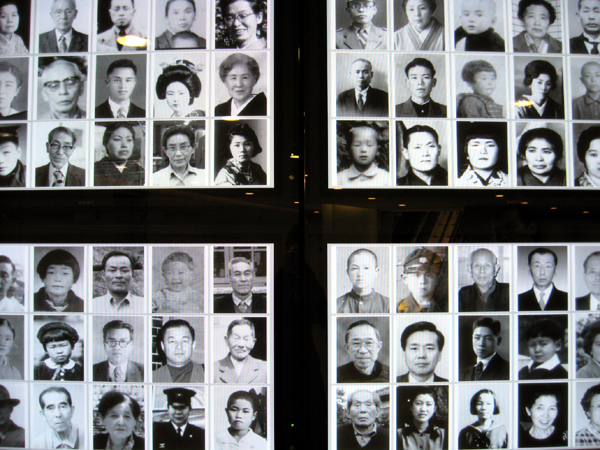11.22.2007 | Hiroshima

Thanksgiving. An early morning to catch the shinkansen for Hiroshima. The air was bright and crisp, with golden sunshine for us to make a first walk from our ryokan to the subway. Our route crossed the Kamogawa and sure enough the wide flat bed was loaded with ducks and some elegant white cranes. We paused to watch them bathe in the warming light.
We got our beignets but saved the eki-ben for our transfer at Shin-Osaka—because we would ride really fast for 20 minutes from Kyoto and then stop at the big Shin-Osaka station for 45 minutes before the next leg. We bought katsu sandwiches and tea and coffee before boarding and promised to buy matcha KitKats on the return visit.
This ride rougher than the last. A faster, newer train that roared like a jet engine. The route is mountainous; I swear that we spent half the ride in tunnel, blasting through darkness. Seems we emerged at Kobe perched on a hillside and then we went back in again until just before Hiroshima.
We discovered Hiroshima to be about 20 years behind Kyoto and Tokyo. The buildings were old, things low-tech. Bathrooms hadn't been upgraded to have western-style toilets or toilet paper or soap or towels to dry your hands with. Maps and directions were not easily located; it took awhile to orient and to find the tourist office, where we could get our hands on a good map. Trolleys serve the attractions from the station. We boarded one of those and rode it through the stations announced in Japanese until the one that suddenly wasn't: A-Bomb Dome. On the way, we passed department stores, a Tokyu Hands, etc. I was struck by how much of a blue-collar, industrial town the city is. It clearly is a place that makes things, but the money doesn't stay there.
We crossed the road from the trolley directly to Peace Park and the A-Bomb Dome, which is that famous skeleton that symbolizes the city. It was at once banal and thought-provoking, and I felt confused by that duality. No one spoke, some read plaques. People quietly photographed the building. I don't know why it felt impolite to speak.
The larger park lies across the bridge from the dome. There we found more tourists, busloads of them from Japan and a smattering of European travelers. School children in uniform roved and flung occasional hellos, most keeping their distance. We saw the vast display of cranes, each 1000 brought to the city by visitors. And we sat through several oral histories in the new memorial dedicated to collecting stories.

Hungry, we left the park for lunch and found a funky little cafe stuck in 1980s Japan, of the country's embrace of foreign food and western dining styles. Tampopo-era. It was empty and we sat alone against a wall of window next to a relatively quiet town. Andrew ordered curry and I ordered pizza and a coke. The pizza was good, the silverware rococco and heavy.
After, we walked back across the street to the park and the musuem. Short on time now. I don't know how to describe the museum really. It was a bit old and low-tech. 1980s. American museums have been updated in the past 20 years to become interactive playgrounds. Maybe we're used to that. When you enter you begin at a starting point and you follow a path through the museum beginning at the start of the war and the events of the war that led to the United States devising a plan to build an atomic bomb and the later events that led the United States to consider Japan a target for the bomb.
The museum has previously sealed documents that reveal rather premeditated, scientific intent that is coldly, calculatedly barbaric, and yet that is totally expected from any machine of war and no different from any such machine on the planet. It wasn't the first time that I'd been presented with the intent to make a gruesome experiment out of the bombing as if that intent were the only one of its kind in the history of the world. That is not what makes the Hiroshima devastation unique.
I found the omission of the battle of Okinawa curious. There, thousands upon thousands died and the magnitude of that loss sold the parsimony of a single source of devastation that would not require the deployment of U.S. Forces.
I looked for denials but didn't find them. Japan continues to fail to acknowledge or to barely acknowledge the atrocities it committed during the war. In the past, schools in Japan have even taught that the United States was the aggressor against Japan. But I didn't see that. To my surprise I saw instead a call for Japan to acknowledge the atrocities it committed in order to be able to fully process its own suffering and the imperative of peace.
The path continues through the facts of the events to the location and time of detonation and the total, nearly unrecorded event. The few images somehow captured were displayed again and again, and these are the few precious ones you've seen because they are the only ones there are. Further along, a replica of the dome. A stopped watch and another stopped watch.
Then we move on into the atomic age and subsequent detonations, one after the other, until we realized the museum was about something other than the Hiroshima nuclear blast. On to a long list of nuclear accidents you wouldn't know about, inventories of nuclear arsenals, lists of leaders and whether they agreed to reduce their stockpiles or authorized the production of more weapons, until the city comes right out and declares itself anti-nuke. And that is the part that suddenly stands out because when has any government entity taken such a steadfast anti-nuke position? How terrible that it is an oddity.
Then you are deposited into the book store where you can buy NO NUKE shirts (which Andrew told me about later) and myriad books. I bought Barefoot Gen.
The special exhibit is in the next room and this season's exhibit focuses on the school children killed instantly or who managed to crawl home with their skin scorched and hanging from their limbs and body. Many school children were conscripted to demolish downtown buildings in order to create firebreaks. The morning of the bombing, many children were at work at the downtown sites and thus were among the most numerous of the population directly beneath the detonation. All that survived were the parts of the clothing not directly seared by the blast. Some other artifacts that parents had saved were hair and the skin that had fallen off their children and dried. One child's whole thumb melted off had been saved.
We rushed the last bit because we were out of time, and when we rounded the last corner on the exhibit we dashed for the door and retreated through the dusk to the trolley stop. Along the way the geography seemed to have more depth. I noticed that the enormous stones in which the trolley rails were ensconced matched the stones in a photograph taken of the devastated city. They had survived and are still in use. The car was crowded and we were pressed in. Germans and French people onboard with us were headed for the shinkansen and towns where travelers stay. I found a narrow slice of seat beside a sleeping Japanese woman whose head bobbed just to my shoulder and then righted itself again every few minutes. Next to her a French couple debated the politics of nuclear war (in French). The woman sat and the man stood, and they were loud. Later, the man sneezed a wet one that sent his partner strafing and the woman next to me into my lap. Every person on the trolley leaned away from him.
Back on the train long and loud. We arrived in Kyoto in time to eat at Kushikura, the grill restaurant where we ate that first night in town last year. I think it's popular with expats because the food is nouveau cuisine done up in a machiya setting. The long old house is lovely, with a large garden around which the house flows. We ordered a long set meal of various grilled things and a salad. It came rapidly and too much for two people but all of it was delicious. My favorite is the fresh salad of large sticks of daikon, green onions, and bell peppers served on ice. You dip the sticks into house-made plum sauce that is as salty as it is sweet.